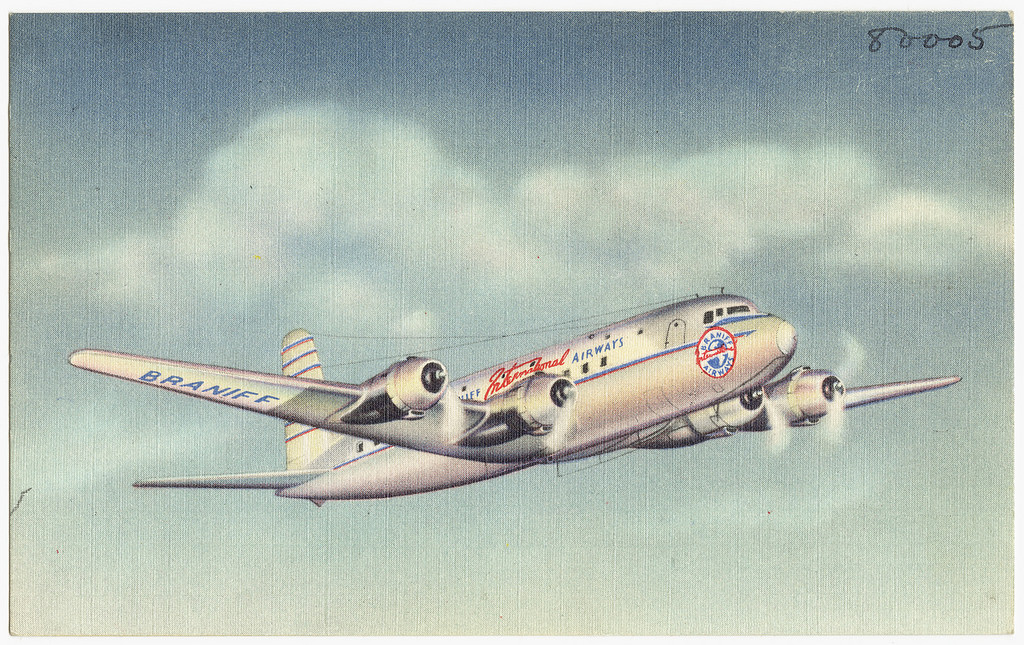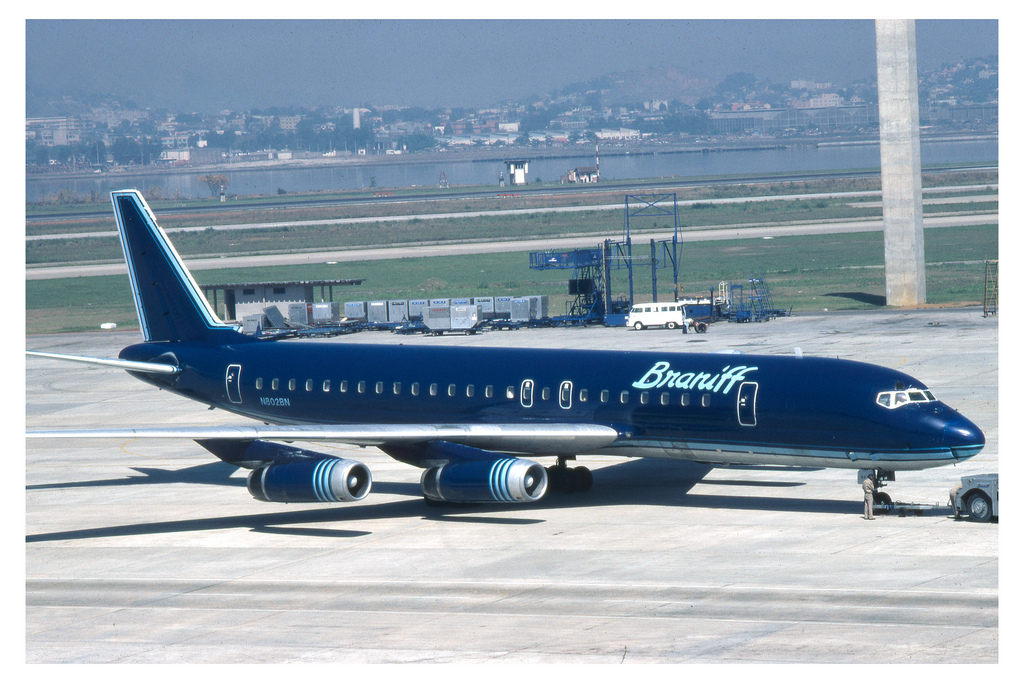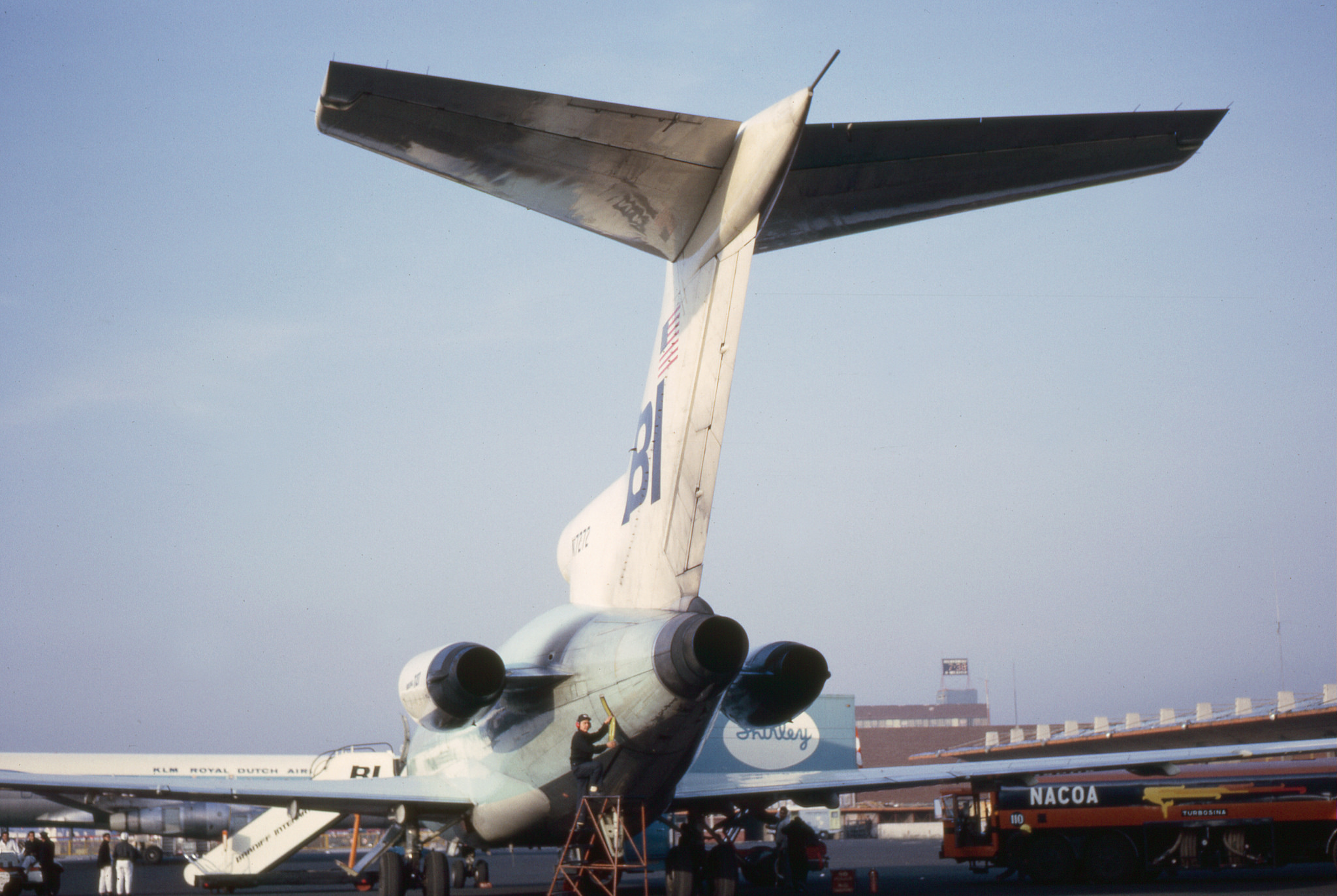 Courtesy Boston Public Library
Courtesy Boston Public Library
Today Senior Contributor R.D. Sussmann-Dewberry returns with part 2 of his stellar three part series on the history of Braniff International. He has previously written fantastic pieces about the modern rise of Delta, the new American Airlines, the History of Low Cost Carriers, United Airlines, the History of Air Shuttles, The Middle East 3, Alaska’s purchase of Virgin America, United’s Polaris and Slim Line Seats. He has been involved with the airline industry for over 20 years and is an active travel consultant and airline analyst. R.D. is also a huge #Avgeek, a theme park enthusiast and a friend.
Navigation:
- Part I: Braniff – from Stinsons to Flying Colors
- Part II: Braniff – Ultra Colors, ultra problems.
- Part III: Braniff – Those who do not learn from the past are doomed to repeat it
Braniff’s history & circumstances were very rare for the time. A major airline had never been allowed to fail by the US government prior to this event. However, there are many facets as to what caused their downfall – and in a lot of ways, many lessons to be learned.
So what did bring Braniff down? Overinflated egos of their leadership? Economic recession? Competition? Degredation of the quality & reliability of service?
The answer is “Yes” – and then some.
The real roots of Braniff’s downfall lay prior to deregulation. Harding Lawrence’s drive to grow Braniff was well known – he wanted a truly national network carrier that could compete with carriers three times larger. At the same time, the competition saw what Braniff was doing with frequency of flights – and they were learning fast.

Across the city from DFW, at Dallas/Love, a little airline was following part of the Braniff formula – in that frequent flights & good service = passengers. And by the start of deregulation, they would start making inroads into that. Southwest was already carving up the state into their own private territory – and Braniff did feel the pains from this in the form of lower fares & more competition. However, a good deal of their Texas traffic then flowed onto other cities in their system, and that kept things in check.
The first failings could be seen with 1977’s plans for the future under Deregulation. Braniff at the start of 1978 had little debt, few outstanding creditors, and solid performance systemwide. Lawrence’s assumptions about deregulation were valid – though incorrect – that it would be temporary. He knew that under the CAB’s control, gaining growth & expansion had been difficult, and that the window would be open for growth for a limited time – and that once that window closed, the process of growth would be challenging. In order to do this, he began a shopping trip en masse with Boeing to expand the carrier by the dozens. Adding in the international route expansion with larger 747 equipment added even more debt. By the end of 1978, the balance sheet was awash with long & short term debt at higher interest rates than previously seen.
The second part is the mega-expansion had been an abject failure on an epic scale. Braniff rushed into the expansion without putting proper foundations in place to handle the growth. Crews were poorly trained in the art of hospitality; out stations were not staffed properly, and the influx of new planes taxed their operations systems to beyond their limits. While they had built a reputation for reliability, quality service & on time performance, the massive expansion shredded that quickly. It takes a lifetime to build a good reputation, and only one bad mistake to ruin it – as many US carriers have found out over the past 15 years.
At the same time, in order to fully activate many of the routes of deregulation, Braniff thinned out their schedule from the Dallas hub – dropping frequency to add city pairs which had no connectivity to the system’s flow. Bob Crandall saw this – and moved in quickly. While American shed many odd city pairs they were awarded under regulation, they also began to build up the DFW hub quickly, taking on Braniff in every single market they were flying to, often with better frequency & timing. Add in the ill-fated experiments by John Casey at Braniff to remove First Class from their core markets, and these travelers moved to American – and to others. With each city Braniff thinned out, American moved right in, and took over.
The third issue Braniff had no control over – the economy. OPEC’s production cuts and the rising crisis in Iran caused fuel prices to skyrocket 94% in one year – and supplies to dwindle, leaving an already fragile economy in shreds. Airlines are always susceptible to the whims of recessions; we have again seen this over the past decade. When the economy tanks, people stop flying. And when people stop flying, airlines begin to feel the pinch.
This was the exact case at the start of 1979, and well into Braniff’s final years. Airlines were competing for fewer passengers at a time when all carriers were trying to digest their post-deregulation expansions. Combine that with the CAB’s removal of fare restrictions & pricing in 1980, and it was a recipe for disaster. Every US carrier was feeling the pain, and though fuel prices began to subside in early 1981, the PATCO strike on the Air Traffic Control system left airlines only able to operate a handful of their schedules.
All of this led to a perfect storm of financial turbulence for Braniff. And it left some huge issues in trying to figure out how to stay solvent, which there was no solution for. Fiscally speaking, Braniff’s failure was a situation where they went into it with one assumption – and left it in failure.

I cannot completely blame Lawrence for this, though there had been questionable management under his reign. With hindsight being perfect, we see that his assumptions and ideas of deregulation were poorly chosen – along with putting Braniff heavily in debt to fund it. He was well known not to pay attention to his advisors & fellow leadership team, and there is some question as to whether he should have been dissuaded into the mega-expansion as planned. There are several groups of ex-Braniff staff who question his management style, and they have a right to do so. But in all fairness, Braniff was facing issues beyond the overexpansion that nobody could have anticipated being so severe.
The fourth factor, and one that we see nowadays often, is the service factor. Prior to deregulation, Braniff had a high reputation for quality, reliability & on-time performance. By operating the carrier with a single type of domestic plane (The 727) and having a well-timed schedule kept their fleets moving – and passengers happy. Offering a frequent & steady service schedule allowed their customers the ability to go out & back to a city in a day, and still be home in time for dinner. And in-flight, Braniff concentrated on ensuring that the product was professional, quality & appropriate to the time of day & the distance traveled. Service was tailored to fit the needs of the customer, instead of the needs of the carrier. As Braniff entered the mass expansion, and the standards fell, so did the repeat customer, who would go to whichever carrier could do it better. In the case of their largest single city, Dallas, people emigrated to American, who swallowed up their customers as quickly as they could. In other cities, the same pattern happened, and Braniff’s customer base began to shrink rapidly.
Braniff’s downfall was immense – by far, the bankruptcy shook the industry down to the very roots. Carriers no longer felt safe & secure that the government would be there if there were problems. And it started a precedent that would be followed by almost every major airline in the USA over the subsequent 30 years. Not long after Braniff’s shutdown, nearby Continental Airlines was bankrupted by their parent company, Texas Air Group in a similar manner. And by the end of the decade, other carriers would follow in Braniff’s footsteps: Pan American, Eastern Air Lines and countless upstarts which had failed to survive.
What we can learn from Braniff is this: It is possible to produce a great product, do it well, and make money at it being true to what your core market is. It is also possible to degrade your product & reputation to where your customers will fly elsewhere. And it is possible to fail miserably by not paying attention to what the customer wants.
Navigation:
- Part I: Braniff – from Stinsons to Flying Colors
- Part II: Braniff – Ultra Colors, ultra problems.
- Part III: Braniff – Those who do not learn from the past are doomed to repeat it



[…] Part III: Braniff – Those who do not learn from the past are doomed to repeat it […]